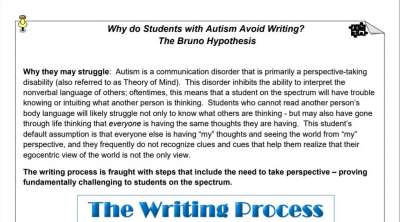Alex Cohill is a special education teacher with ten years of experience serving students with severe cognitive disabilities and specializing in phonics instruction, assessment tracking, and functional learning.
Embrace differentiation and a student-centered learning mindset with these simple, impactful steps.
Embracing Differentiation: A Mindset for Effective Student-Centered Teaching
Differentiation as a State of Teaching
In the dynamic landscape of education, fostering a learning environment where every student can thrive is an ongoing pursuit. We use the word “differentiation” almost flippantly to address how teachers are meant to achieve this feat. It’s easy to fall victim to traps of over-planning and pre-determining ability as a means to anticipate each student's needs. I invite all teachers to step back and not view differentiation as merely a set of instructional strategies but as a profound mindset that educators can adopt to meet the diverse needs of their students. Ditch the overly rigid plans and open up to the idea of teaching in the moment. Delve into the essence of differentiation as a state of teaching and explore its key facets. By embracing this mindset, educators can unlock the true potential of their students and facilitate meaningful learning experiences by assuming the most appropriate role (read: mindset) for their students.
Defining Differentiation and More
At the heart of differentiation lies a need for a clear understanding of its basis. Differentiation encompasses tailoring instruction to match student readiness, interests, and learning profiles. It involves providing appropriate challenges that stretch students beyond their current abilities, aligning with Lev Vygotsky's Zone of Proximal Development (ZPD). Differentiation is not about creating an exhaustive array of separate learning experiences but about personalized adjustments within a unified educational framework that exists in your classroom.
To differentiate based on readiness requires a diagnostic assessment to determine if students have the necessary prior knowledge or “base” to move onto whatever standard a lesson addresses.
To differentiate based on interest, allows educators to alter the materials students use to access a concept or idea. Allowing students to engage in interest-based learning opportunities will ensure that they are more engaged, and will also increase the likelihood that they are successful with novel concepts.
To differentiate based on learning profiles, educators can assume how the material is being offered will be most effective. By knowing student learning profiles we can adopt the mindset of whatever type of coach a student needs. This takes the most time for an educator to learn about students but will yield the most value in effectively differentiating instruction.
Learning Profiles and Readiness: Navigating the Diversity of Minds
The diverse landscape of student learning profiles and readiness levels demands a nuanced approach. Learning profiles, as described by Mumford and Honey are: activist, reflector, pragmatist, and theorist. They contend that students move through these learning approaches over time fluidly. Each learning style is best met with a mindset adopted by the teacher. By acknowledging and integrating these styles, educators create an environment where students can learn from discovery, embrace challenges, and engage in meaningful conversations by reaching the…
Zone of Proximal Development: Guiding Light for Differentiation
At the core of differentiation lies the Zone of Proximal Development (ZPD), a concept coined by Lev Vygotsky. This zone presents a range of abilities a student can perform with expert guidance but cannot yet accomplish independently. Teachers, as guides and scaffolders, have the pivotal role of identifying and expanding this zone, ensuring that each student is optimally challenged and supported.
Differentiation in Action: The Educator's Roles
Differentiation occurs when educators wear multiple hats – that of a guide, model, facilitator, and scaffolder. Each role is integral to creating an environment where students can flourish. For an activist learner (who learns by doing) teachers can offer process-based instruction and critique based on students’ outcomes by assuming the role of a guide. For students who are reflectors (who learn by observation and study), educators can assume the role of a model and demonstrate effective problem-solving approaches. For students who are pragmatists (learn by creating frameworks/real-world models) teachers can assume the role of a facilitator and offer examples and opportunities (videos, demonstrations, pictures) which align with the student’s needs. For students who are theorists (learn by gathering all available info and forming a plan) teachers can assume any of these roles to provide the necessary base of prior knowledge these students need to attack a problem.
In each of these roles, the educator must act as a scaffolder. Educators must determine, in real-time, how significant a student’s layers of support must be. Regardless of the role an educator assumes in working with a student, the level of support the student needs will vary. By scaffolding instruction to allow students to reach the ZPD, teachers can ensure that they and their students are maximizing their learning opportunities.
We must steer clear of mindset traps that can hinder the true essence of differentiation. Differentiation is not synonymous with complex lesson plans or an unsustainable frenzy of diverse activities. It thrives on evidence-based instruction, timely assessments, and a presumption of student competence. The key is to pay attention to students' real-time progress and needs, fostering growth through challenge and struggle.
Embracing Discomfort: Differentiation and Student Growth
A crucial aspect of the differentiation mindset is embracing discomfort as a catalyst for growth. Contrary to misconceptions, differentiation does not eliminate struggle from the learning process; rather, it harnesses the power of challenge to foster resilience, confidence, and deeper understanding. Students navigate uncharted territories of knowledge daily, led by the teacher as a guide, model, and facilitator.
In adopting these mindsets a teacher’s success with differentiation is amplified through practical strategies such as tiered assignments, flexible grouping, or tailored materials that educators can seamlessly integrate into their teaching toolkit. The key is knowing when students are truly in the ZPD, feeling appropriately challenged, and not experiencing frustration. That level of frustration offers no benefit and hinders growth.
How can I do that? The Power of Real-Time Assessment in Differentiation
Embedded assessment forms the backbone of effective differentiation. It empowers educators to gather real-time data on student understanding and adjust their approach accordingly. A teacher armed with a clipboard, a Google Survey, or even a thoughtful conversation can gain insights into each student's journey. By intentionally designing assessment questions, educators can uncover not only what students know but also how they think and approach problems. Have a few questions jotted down on your clipboard. This demonstrates preparation and positions you to “think on your feet” when interacting with students. Asking, “Can you walk me through how you solved this?” Or “What was your first step?” provides a deep insight as to what process our students undertake. Moreover, by checking in regularly, an educator can keep a finger on the pulse of whether or not students are approaching a level of frustration.
Embracing Differentiation as a Mindset
Differentiation is not just a set of techniques but a transformative mindset that empowers educators to elevate their teaching practice. By anchoring instruction in student readiness, interests, and learning profiles, educators unleash the potential of each learner. Embracing discomfort as a path to growth, leveraging assessment as a guiding compass, and recognizing the educator's multifaceted roles further enrich the differentiation experience. Teach” in the moment.” Each lesson is different and students surprise us every day. Let them - and then confidently step into the world of differentiation by leading them in the best way possible to their full potential.















